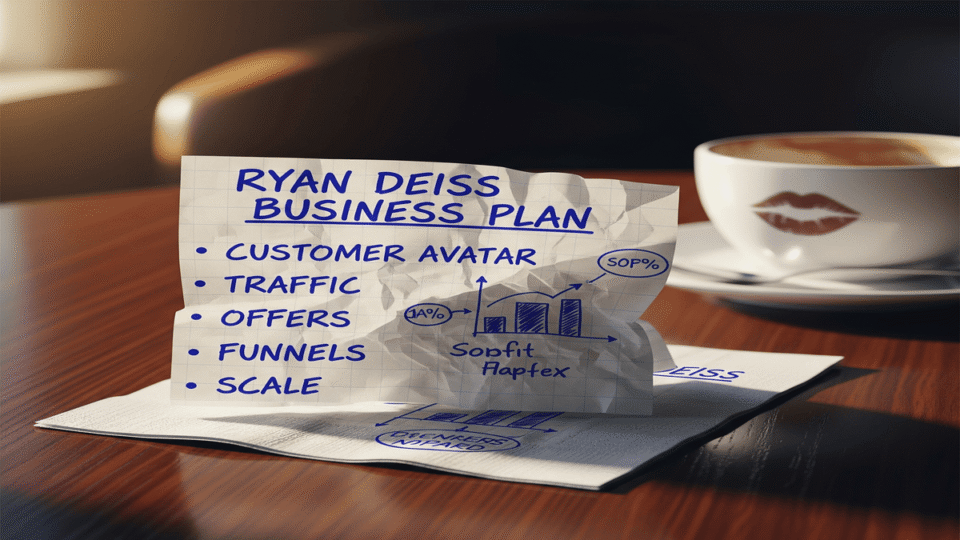When most people think about creating a business plan, they imagine dozens of pages filled with financial projections, charts, and long explanations. While traditional business plans have their place, not every entrepreneur needs something so complicated to get started. Marketing expert Ryan Deiss introduced a fresh, practical approach called the “Business Plan on a Napkin.”
This simplified framework helps entrepreneurs map out their business idea quickly and clearly, without getting lost in overwhelming details. It’s especially helpful for startups, small business owners, and anyone looking to validate an idea before investing too much time or money.
Who is Ryan Deiss?
Ryan Deiss is a well-known entrepreneur, author, and the founder of DigitalMarketer. He has helped thousands of business owners build scalable, profitable companies by simplifying marketing and strategy. His “business plan on a napkin” concept has gained popularity because it makes planning accessible—even to people who feel intimidated by formal business documents.
What is the Business Plan on a Napkin?
At its core, Ryan Deiss’s model strips a business plan down to just a few key elements. The idea is simple: if you can’t explain your business clearly and concisely enough to fit on a napkin, you probably don’t understand it well enough yet.
This plan usually fits onto one page and answers essential questions:
- Who is your customer?
- What problem are you solving for them?
- What is your solution (product/service)?
- How will you reach your customer?
- How will you make money?
Why This Approach Works
- Simplicity: You avoid being overwhelmed by unnecessary details in the early stages.
- Clarity: If you can explain it quickly, you can pitch it better to investors, partners, or customers.
- Flexibility: A short plan is easy to update as your idea evolves.
- Speed: You can start testing your idea instead of getting stuck in endless planning.
Key Components of Ryan Deiss’s Business Plan on a Napkin
1. Define Your Customer
Who are you serving? Be specific—your customer is not “everyone.” For example, a boutique gym might target busy professionals who want efficient, high-quality workouts.
2. Identify the Problem
What pain point does your customer face? Successful businesses solve real problems. For instance, customers may want healthier meals but lack time to cook.
3. Present Your Solution
This is your product or service. How does it directly solve the problem? For example, a meal delivery service provides quick, nutritious meals.
4. Plan Your Marketing Channels
How will you reach your target audience? Options include social media, paid ads, content marketing, or partnerships.
5. Revenue Model
How will your business make money? Will you charge a subscription fee, a one-time purchase price, or offer a freemium model?
Benefits of the Napkin Plan Over Traditional Business Plans
- Quicker to Start – No need to spend weeks drafting documents.
- Investor-Friendly – Some investors prefer concise, clear pitches.
- Keeps You Focused – Avoids getting lost in non-essential details.
- Encourages Testing – Puts emphasis on real-world validation instead of theory.
Real-Life Example
Imagine you want to start a pet grooming mobile service. On your napkin, you might write:
- Customer: Pet owners in urban areas.
- Problem: Lack of time to take pets to grooming salons.
- Solution: Mobile grooming van that comes to customers’ homes.
- Marketing: Local SEO, flyers, social media ads targeting pet owners.
- Revenue: Flat service fee per session.
In just a few lines, you have the foundation of your business.
How to Create Your Own “Napkin Business Plan”
- Grab a sheet of paper (or yes, even a napkin).
- Write down your answers to the five core questions.
- Review and refine until your plan is crystal clear.
- Share it with someone else—if they don’t understand it, simplify further.
- Start testing your idea in the real world.
FAQs About Ryan Deiss’s Business Plan on a Napkin
Q1. Why did Ryan Deiss create the “business plan on a napkin” concept?
He wanted to simplify business planning so that entrepreneurs could focus on clarity and execution instead of getting stuck in complex documents.
Q2. Is a napkin business plan enough to get investors?
Yes, in the early stages. Many investors appreciate clarity. However, for larger funding rounds, you may still need a detailed plan and financials.
Q3. How is this different from a one-page business plan?
They are similar, but the napkin plan emphasizes extreme simplicity—boiling things down to the absolute essentials.
Q4. Can this method work for large businesses too?
Yes. Even established companies use simplified frameworks to refocus strategies and clarify their value propositions.
Q5. What should I do after writing my napkin plan?
Test your idea in the market. Talk to potential customers, launch a minimal version of your product, and refine based on feedback.
Conclusion
The Ryan Deiss Business Plan on a Napkin proves that building a business doesn’t have to be complicated. By focusing on the essentials—customer, problem, solution, marketing, and revenue—you can quickly create a clear, actionable plan. Whether you’re starting a side hustle or aiming for the next big startup, this approach helps you move forward with confidence, simplicity, and speed.

